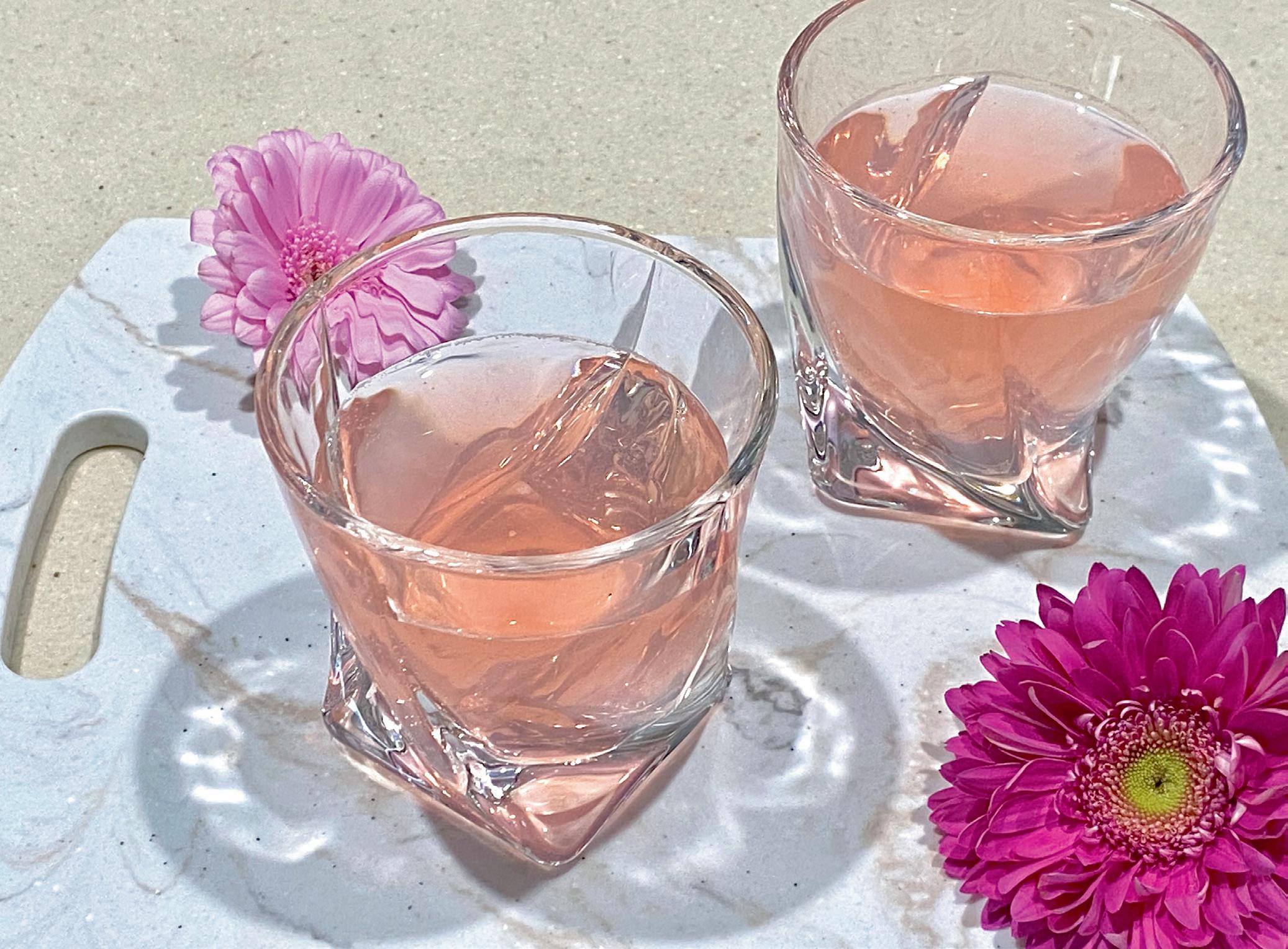
9 minute read
Sweetening the drink without the sugar
Reducing the consumption of sugary drinks in remote Indigenous communities and creating business opportunities are the twin aims of University of Queensland PhD candidate Jessica Cartwright’s research.
As part of the team led by Dr Olivia Wright at the Australian Research Council Training Centre for Uniquely Australian Foods, Cartwright is working to develop a soft drink using native ingredients and less sugar.
“In Indigenous communities there are higher rates of sugarsweetened beverages consumed than compared to the rest of the country,” Cartwright said.
She said a few interventions to reduce sugar-sweetened beverage consumption in these communities have been tried and tested without addressing the root cause.
“These programs are often ineffective or not sustainable long term, so we’re coming up with an alternative approach.
“We are creating a healthier drink using native ingredients to empower communities and connect them to Country.
“Our drink has a base of Kakadu plum, and our current prototype also has a little bit of Davidson plum, but the goal is when we start to work closely with specific communities if they grow Finger lime for example, we will try to include that.
“We really want them to be able to take ownership of the drink to create an Indigenous enterprise.
“There is also the route of commercialisation down the track, but all the profits would be going to the Indigenous communities.”
Michelle On from Kiril Park Wild Harvest said as an Indigenous person, she has seen firsthand the impact of chronic disease from poor diet and is happy to be involved with a project aiming to address the issue.
“It’s really sad to see chronic diseases affecting Indigenous people when traditional foods have so many nutritional benefits,” On said.
“I hope awareness will lead to healthier eating habits and this Kakadu plum beverage is the perfect alternative to high sugar soft drinks.
“Encouraging people to change eating habits and include more bushfoods is putting cultural foods back in a staple diet, and will not only have nutritional benefits but will boost cultural knowledge of bushfoods.”
Cartwright has found that taste is one of the most common factors that influences sugar-sweetened beverage intake, “which is why it is imperative that its acceptance is comparable to that of a regular soft drink”.
She said not only would the drink contain less sugar, but its native ingredients would ensure it was also nutritious.
“We’ve done preliminary testing and found that, because of the Kakadu plum, the drink has a lot of vitamin C,” Cartwright said.
“This is beneficial, given our consumer is remote Indigenous communities where access to fresh fruit and vegetables and the nutrients they provide can sometimes be limited, and expensive.
“Overall, I think this idea of trying to create a substitute to decrease full sugar soft drink consumption had not even been considered up until this point.
“It has been an honour co-designing this beverage with the training centre’s Indigenous partners.”

Perfect Your Products with Greater Efficiency and Innovation
From food to pharma, cosmetics to chemicals, Fluid Air is delivering big ideas that help you preserve active ingredients, accelerate production, and reduce waste — all with cost efficiency in mind.
Fluid Air is defining the next generation of spray drying technology in the food industry by creating scalable powder manufacturing solutions. Our innovative PolarDry technology utilises electrostatic charge and milder temperatures to achieve conversion, leading to large efficiency gains for your business, whether it be in high-value dairy, flavouring or essences.
What is PolarDry Electrostatic Spray Drying
PolarDry electrostatic spray drying is a low temperature drying technique that combines gas–liquid atomisation and electrostatic charge in a single-step process for conversion of liquid feed to powder.
In both traditional spray drying and in the PolarDry® process, liquid droplets are atomised and sprayed into a stream of drying gas. Then, heat is transferred from the drying gas to the liquid and the solvent is evaporated resulting in a dry, powdered material.
With PolarDry technology, spray drying has advanced to implement an electrical charge at the drying step, and this allows efficient drying at low temperature and improves encapsulation efficiency for lipids and volatile components.
Businesses across Australia already depend on spray technology from Spraying Systems Australia.
How is Fluid Air revolutionising the process?
Our new innovation promises to enable our customers to better retain the biological activity of heat- and oxygen-sensitive products after drying, compared to more traditional methods that use extreme heat.
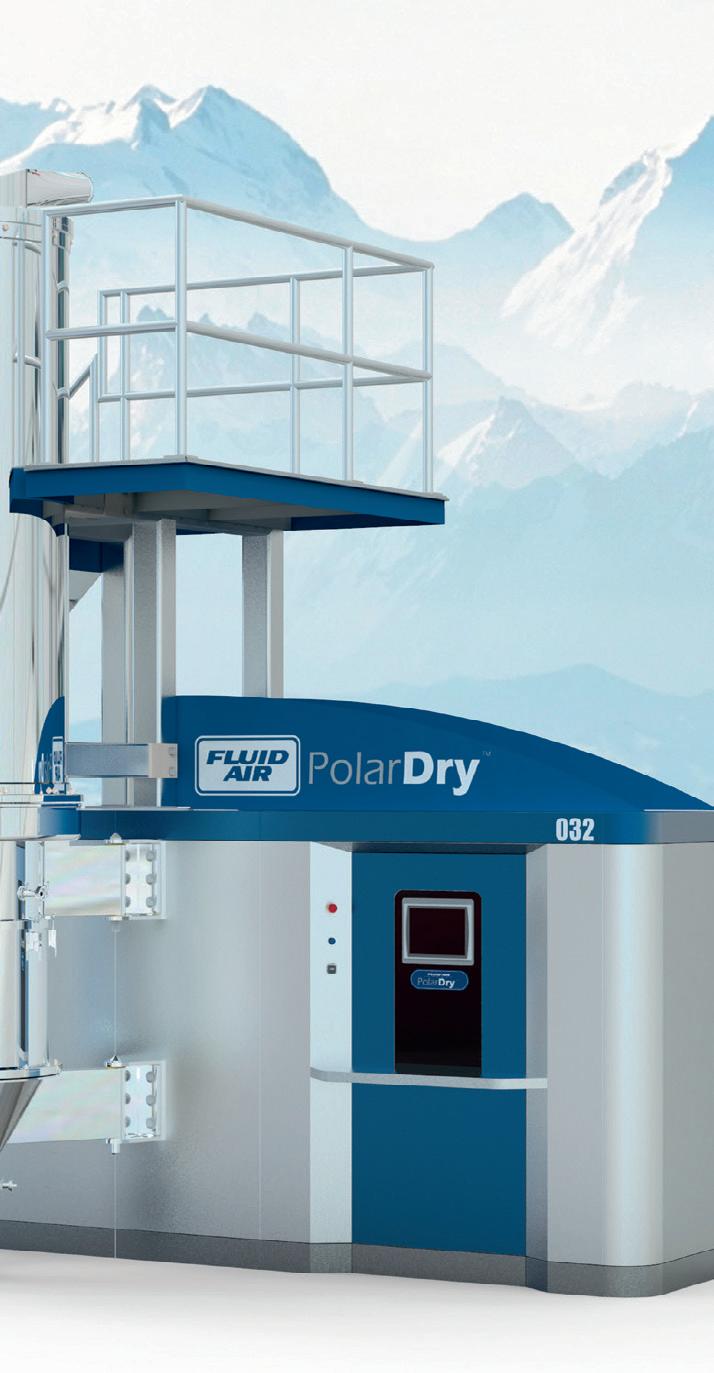
Lower drying temperatures during electrostatic spray drying causes less damage to the products that we make. This helps to preserve the bioactivity of heat-sensitive materials, such as microorganisms, proteins, bioactive materials, pharmaceuticals, etc.
Fluid Air’s streamlined, one-step process allows water evaporation at a significantly lower processing temperature (<90°C) and, in tandem, enables an agglomeration process to take place before particles are completely dry.
We do this by driving the water or solvent to the outer layer of the atomised droplets and the solids to the core. This in turn lowers the required evaporation temperature and eliminates active ingredient loss, degradation, or denaturation. Harnessing the electrostatic effect, non-polar active components can be driven to the core and efficiently microencapsulated, reducing surface active losses and resulting in greatly increased encapsulation efficiency.
Unlike traditional high-heat spray drying, electrostatic spray drying takes place in an inert gas environment where oxygen is replaced by nitrogen. This expands applicability to oxygensensitive materials and not only appeals to anaerobic microorganisms, but it is extremely well suited to spray drying of oxygen-sensitive lipids and other reactive materials.
Our technology handles a variety of products ranging from microencapsulated oil emulsions, living microorganisms, bioactive proteins such as lactoferrin and immunoglobulins, other biological materials and, to a lesser degree, inorganic materials.
Normally with traditional high-heat spray drying technology there is a reduction in bioactivity after drying of biological materials, but in our electrostatic spray drying technology there is almost no loss after drying.
And when we store our products for longer period, the bioactivity is maintained.
Lastly, electrostatic spray drying also provides an efficient, one-step unit operation that surpasses other technologies within this space.
Fluid Air provides complete solid dosage solutions, so if you are handling or manufacturing powders at any scale, whether it be in fluid bed drying, agglomeration, granulation, dry blending, particle sizing, spray drying or coating, contact us today.
PolarDry PROCESS BENEFITS
• Low operating temperature allows for efficient drying of heat-sensitive materials • Greater encapsulation efficiency for lipids and volatile components • “All-in-one” modular equipment design features a small footprint which reduces maintenance and installation costs • SAFE - Nitrogen Inert • Contained, robust processing • Inner liner makes for easy clean-up/ changeover • Process products with low glass transition temperature (Tg) • Recycled process gas with negligible emissions virtually eliminates regulatory issues • Complete product line that is scalable from
R&D to production-size models • Substantially shorter process time than freeze drying
Contact us today to arrange a trial of your product at our Melbourne facility
Fluid Air’s testing facility in Melbourne has advanced analytical capabilities to support our Australian and New Zealand customers and give the best possible solutions.
Our centre is also flexible, depending on your needs. If you have any specific testing requirement we can fulfil that. In addition to drying the liquid feed into powder, we also can analyse the liquid feed before drying and the powder properties after drying. We can measure the moisture content, water activity and glass transition temperature of the powder. So give us a call and let’s talk about how we can increase your businesses efficiency.
Email: mark.condro@spray.com.au
Spraying Systems Co Pty Ltd www.spray.com.au
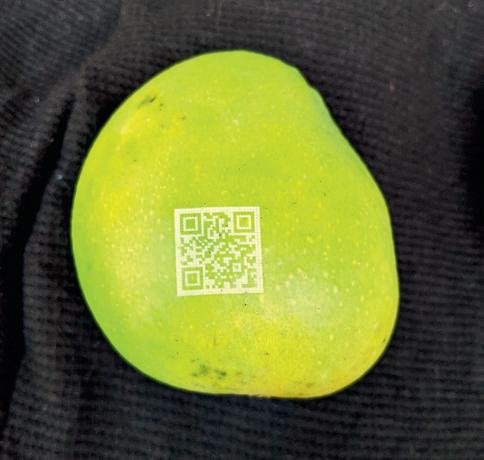
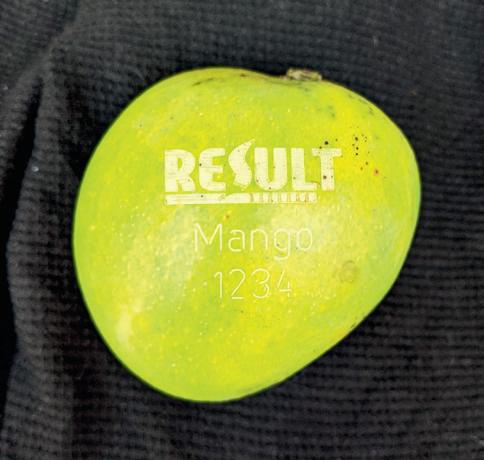
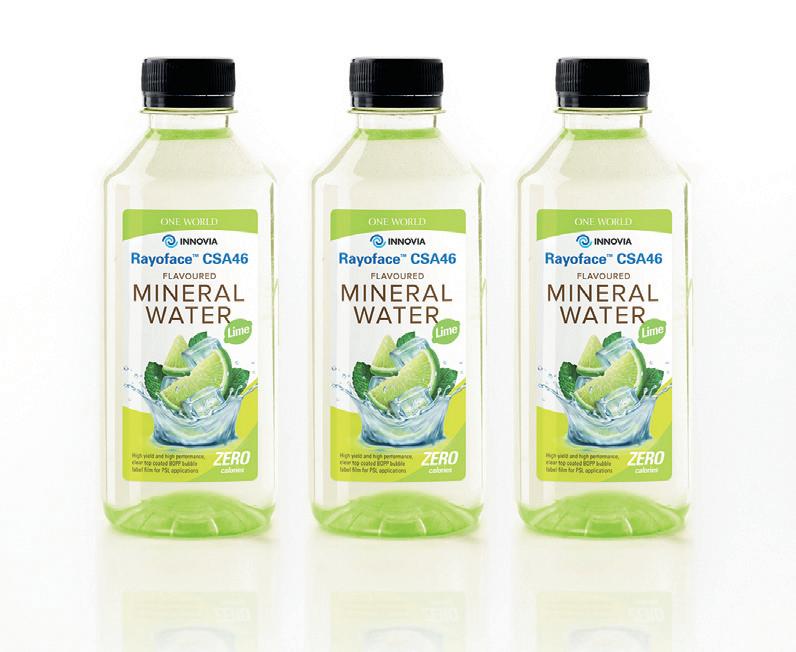
Non-contact labelling technique for food produce
Result Group is introducing EcoMark Natural Branding to the Australian market. The technology is designed to provide a non-contact labelling technique that creates an image on the peel of food produce — a high-resolution laser removes colour from the fruit or vegetable’s outer layer of skin, and acts like a tattoo on a variety of goods. The technique doesn’t use ink and can provide an alternative to produce unit labelling such as fruit labels.
Suitable for use on any food with a robust skin, the laser technology doesn’t require a labeller or consumable. Some examples of applications include: apple, avocado, apricot, banana, passionfruit, corn, capsicum, cabbage, eggplant and many more.
The laser is used for the marking, which can include branding, SKU level identification, traceability and authenticity. The system simply depigments the uppermost cell layer of the fruit’s skin and removes the outermost layer of skin, which is designed to preserve the fruit and vegetable’s integrity.
Due to its adaptability, the system can also be suitable for conventional goods such as bread, biscuits, chocolate and other confectionery products.
The machine is available in two model series in terms of technical specifications — Light and Professional — both of which are simple to operate.
Result Packaging Pty Ltd
www.resultgroup.com.au
Clear film for labels
Innovia Films is launching Rayoface CSA46, a clear, oneside gloss coated BOPP film that is suitable for use in food and beverage or household and personal care applications.
The 46 micron film is approximately 10% thinner than most facestock films, giving it a higher yield and an improved carbon footprint.
Rayoface CSA is a high-clarity and low-haze film that gives enhanced product visibility and the ‘no-label look’ appearance.
The material has a wide print window and is suitable for printing with flexo, gravure, screen offset and letter press, and also with UV, low-migration and water-based inks.
Features include good cold foil adhesion and appearance, which allow for eye-catching graphics and label designs.
The material has EU food contact compliance.
Innovia Films Pty Ltd
www.innoviafilms.com
Slimline pushbutton unit
Safeguarding using safety gates is essential where palletisers and robots encounter humans during packaging. With the pushbutton unit PITgatebox, users can easily control safety gate switches and systems with flexibility. The robust control unit with various combinations of pushbuttons, key switches and E-STOP pushbuttons gives users for their individual application.
Another added safety factor is the integration of PITreader which enables user authentication. User permissions are checked via RFID key before the gates are operated. This ensures that the right group of people has access to the plant, based on qualifications and the tasks of the relevant personnel.
With PITreader, commands such as activate, stop or reset machine can be controlled based on successful authentication. As a result, packaging machines are provided with protection against misuse or even manipulation. The control unit can be installed quickly and easily on standard profile systems thanks to the slimline design.
Pilz Australia Industrial Automation LP
www.pilz.com.au










